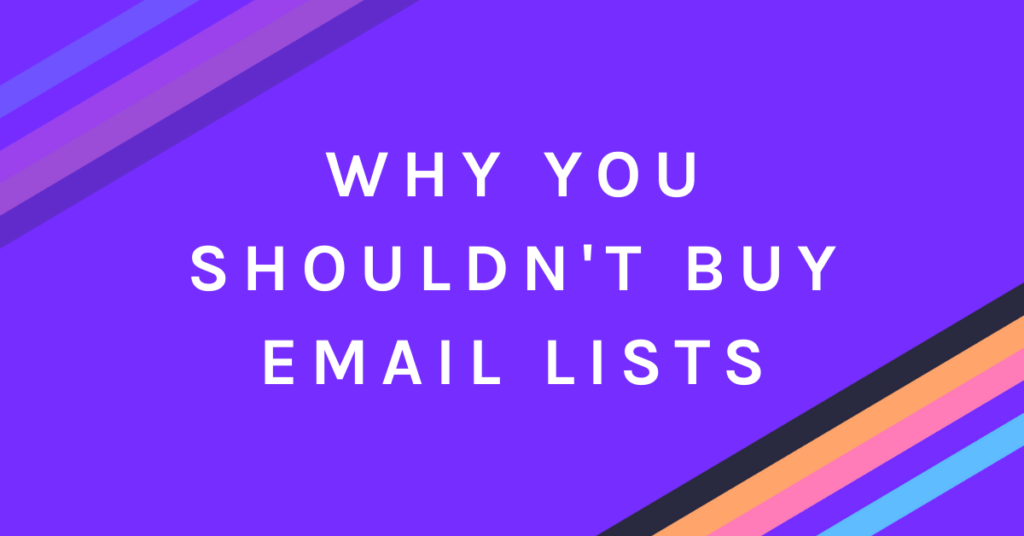We get it: email lists can seem really great from the outside. Really easy and often times really inexpensive. It seems like a win-win: marketing gets to provide sales with emails to contact and it comes at a low cost. But wait! All is not as it seems. There are some seriously negative consequences to list buying and using them as a basis for your marketing efforts. Let’s get into why you shouldn’t buy email lists:

1. The email lists are often low quality.
I often find myself talking about how much time and money marketing automation can save marketers in their day-to-day lives. For good reason: I’m a daily Net-Results user and know firsthand just how much a great software platform can make or break your regular operations. It’s for this reason that I’m confident in saying: lists pretty much always waste way more time and money than they bring.
Why is this? Well, think about it. Your sales team might normally be doing your prospecting and creating lists of potential customers to reach out to. That takes a lot of time, energy, and oftentimes a lot of strategy as well. Email lists are attempting to provide a way around that, but the reality is that the hard work just isn’t done. The contacts provided on those lists are often fudged and low quality.
So all that time and money that you’re saving really isn’t time and money saved at all, because you’re spending money and time on potential leads that aren’t high quality.
2. It damages your domain reputation and email deliverability.
This is a big one and I probably don’t have to tell you why but just in case: marketing relies heavily on emails in order to warm up leads. Your sales team probably also heavily relies on email communications to close leads. If you’re selling anything, you also probably have a Customer Success or Support team that is following up with customers.
All in all, you probably don’t want to be messing with your domain reputation and email deliverability, which is exactly what happens when you buy lists and utilize them for your email marketing. Because you’re contacting people who haven’t consented to be contacted and have no idea who you are, they’re likely to mark your emails as spam and damage your domain reputation and further, your email deliverability.
For more information on how to improve your domain reputation — check out our recent blog post.
3. It can be spammy at best and law-breaking at worst.
Remember a couple of years ago when GDPR got launched? What about CCPA in pre-pandemic 2020? Quick reminder ICYMI:
Essentially, both of these data protection acts were put in place in order to do exactly as they say: protect consumer data. GDPR, aka the General Data Protection Regulation, is the European version which specifically doubles down on the opt-in side of the email relationship between consumer and emailer. It requires that contacts be able to unsubscribe and opt-out of emails directly from the email itself. If your email recipients live in Europe, they’re protected by GDPR.
That protection also means that explicit consent is necessary from your contacts in order to send them emails. This usually means clicking a checkbox in order to opt-in. Buying lists means that those recipients haven’t opted-in. Spammy at best, law-breaking at worst!
Are you a Net-Results customer wanting to learn more about GDPR? Check out the Net-Results Knowledge Base Article on GDPR.
4. Your softwares might not allow it.
Most reputable email marketing and/or marketing automation softwares won’t allow you to use bought lists in their platform. (In fact, it’s probably right there written in their user agreement.)
The problem is that the companies that are really reputable in their domain reputations will usually share IP addresses across customers. This means that one customer’s bought list can affect the deliverability of the other senders emails. It’s best practices for these companies not to allow purchased lists because it’s better for all their clients that everyone has clean contact lists.
So… have I convinced you?
Here are some things you can do instead of buying email lists:
- Focus on your email nurturing and lead nurturing for the leads that are already in your pipeline.
- Build your email lists with content marketing.
- Conduct market research and develop your ICP.
- Target your audience with paid social media and Google ads.
For more information on domain reputation, check out our free Email Deliverability Guide!

